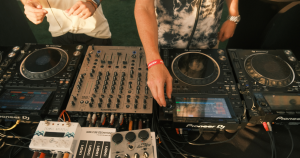If you work in this category long enough, you realize the language hasn’t caught up to the products.
“Non-alcoholic” was sufficient when the section at the grocery store held O’Doul’s and maybe an overly sweet sparkling cider. But today’s landscape is too broad and too innovative to be defined by the absence of ethanol.
As Ben Branson put it in one Dry Atlas interview: “If the ABV of your brand is a core part of your name or your packaging—dangerous red flags.”
Because “non-alc” tells you what something isn’t. It communicates a restriction, not a choice. It centers alcohol as the default, and everything else as the deviation.
This is why we prefer a different term: alcohol alternatives.
It’s more expansive and more aligned with how consumers actually navigate this space. And it reflects what this category has always really been about: optionality.
So what deserves to sit under that umbrella, and what doesn’t? Let’s break it down.
Why “Alcohol Alternatives” is the Better Frame
The category Dry Atlas covers isn’t simply “drinks without ABV.” It’s beverages crafted for the same moments where alcohol historically dominated: the dinner table, the party, the post-shift unwind, the solo nightcap, the date, the celebration.
The semantics matter:
- “Non-alc” implies compromise.
- “Adult non-alc” restricts these beverages to 18+, but still feels like compromise.
- “Social beverages” fits some occasions, but excludes others: plenty of consumers want something sophisticated at 7 PM alone on their couch.
“Alcohol alternatives” communicates optionality. It signals: “This drink belongs in the same ecosystem of sophisticated beverages, even if it doesn’t contain alcohol.”
And as Branson also pointed out: Nobody calls themselves a “non-smoker” or a “non-pork eater.”
Why define an entire category in opposition to a habit consumers are actively moving away from?
“Alcohol alternatives” also opens the door to one of the most important questions shaping the future of this category:
Do THC Drinks Count as Alcohol Alternatives?
In our opinion? Yes. And increasingly, they’re the clearest example.
Many founders and consumers still feel conflicted here, as THC is intoxicating and not “non-alc” in the purity sense. But the ingredient list of a product isn’t what we believe determines its place in the category.
People aren’t buying THC drinks because they want cannabis specifically. They’re often buying them because they want something to replace alcohol in moments where alcohol used to be the default.
One CrescentCanna survey found that while 21.1% of THC beverage drinkers have quit drinking alcohol entirely, 39.6% stated that they simply drink alcohol much less. (And, 16.9% stated they drink alcohol slightly less.)
It’s clear what these consumers want:
- Relaxation
- Sociability
- A ritual
- A sophisticated drink
And they want it without the collateral damages: impaired sleep, hangovers, and all the other things alcohol quietly imposes.
Put differently: many consumers don’t care if the (responsible, legal) “buzz” comes from ethanol, THC, kava, or some yet-to-be-legalized psychoactive. They care whether the drink fulfills the same function and fits the same ritual.
By that logic, THC belongs squarely within the world of alcohol alternatives.
And so will future psychoactive formats, like psilocybin, if regulation allows.
What About Premium Sodas?
A premium soda may be elevated, but that doesn’t mean it fits the same role as an alcohol alternative.
We believe this is a solid litmus test: does the beverage aim to deliver a similar experience, ritual, or level of craft as alcohol? Some guiding distinctions:
- Intention: Products developed with wine, spirit, beer, or cocktail ritual in mind belong in this category.
- Occasion: Nighttime vs. daytime is overly simplistic, but the setting is a useful signal.
- Craft: Alcohol alternatives don’t have to be expensive, but they do have to deliver on thoughtful formulation and a premiumized sensory experience.
That’s simply not the job description of premium soda, so they’re not alcohol alternatives, regardless of where they show up on the shelf.
Where This is All Heading
As menus integrate across ABV levels, as beverage brands span portfolios from infused to not-infused, and as consumers slide up and down the ABV spectrum based on mood, this entire question may eventually become irrelevant.
As the lines blur, ABV may end up as a minor data point on the back label, like sugar grams or caffeine content, not the defining feature of an entire category.
But we’re not there yet, and consumers are still anchored to the product’s relation to the alcohol “occasion.” Framing these beverages as alternatives to alcohol underscores their premium nature and supports the optionality today’s consumers crave.






